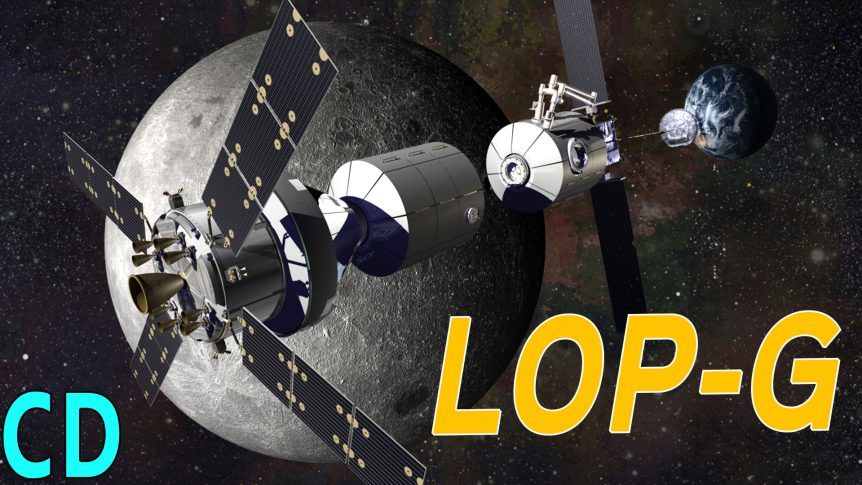Goodbye Deep space gateway, hello “LOP-G”, just in case you wondering what heck I’m going on about. This is the news that the next space station, the one to replace the ISS has had a bit of a Trumpian makeover and will now be called the “Lunar Orbital Platform – Gateway”, instead of the Deepspace Gateway but we’ll come back to that a bit later.
The most expensive object ever built is the International Space Station, which – combining launch, assembly, maintenance and contributions from Russia, Europe, Japan and Canada – has so far cost more than $150 billion US dollars.
Using that price tag, If we assume that the ISS has had some 20,000 person days from 2000 to 2015 that works out at about $7.5 million per person per day, the previous US space Station Skylab was about $5.5 million per person per day.
Even by the standards of space programs, $150 Billion is an astronomical sum. The entire cost of the Apollo program, adjusted for inflation, has been estimated at $109 billion dollars and The Constellation Mars mission which was in 2000, was projected to cost a piffling 40 billion dollars.
The bill for the ISS will also continue to rise: NASA recently committed to a future investment of $3 billion dollars per year until at least 2024. But why has a space station received so much of NASA’s budget, when many other ambitious programmes suffer cuts and cancellation?.
To answer this question, we have to look back at the history of the first space stations in Low Earth Orbit. In the 1960s, both the USA and USSR invested in designing massive rockets specialised for lifting ‘super-heavy’ payloads to orbit and on to the moon: the Saturn V could carry an unsurpassed 140 tons to Low Earth Orbit, and the Soviet ‘N1’ was designed to lift 95 tons above the Earth, with its successor the Energeia which flew the Buran in to orbit able to lift 100 tons.
When it became clear that the Americans would be first to land humans on the lunar surface, the USSR shifted their focus to another thing you can do with a super-heavy launch capacity: lifting heavy equipment just above Earth’s atmosphere, and leaving it there.
This shift in focus began an ambitious program of Space Station development, launching four ‘Salyut’ stations and three ‘Almaz’ military stations between 1971 and 1986. America answered with the 1973 launch of ‘Skylab’, a 77-ton station built from a modified upper stage of a Saturn 1B, which hosted three manned crews before re-entering over Australia in 1979, from that point the US concentrated on the Space Shuttle.
Although the Soviet ‘Salyut’ stations were much smaller, at less than 19 tons each, they paved the way for ‘Mir’: the first ever modular space station.
But when the USSR collapsed in 1991, Western governments worried that a ‘brain-drain’ from Soviet rocket labs could provide rogue states with engineers and scientists to spread ballistic missile technology. To avoid this, the American government searched for ways to keep Russian engineers employed in peaceful space projects. One solution was to repurpose the plan for the Soviet ‘Mir 2’ station, to form part of a new ‘International Space Station’. This was agreed upon, and the first modules from ‘Mir 2’ were adapted to form two of the core modules of the ISS the ‘Zarya’ and ‘Zvezda’.
The ISS also provided continued employment for American engineers, and the Space Shuttle, which flew 26 missions to lift the components into orbit. Visible from all over Earth as a bright dot racing across the night sky, the ISS provided an impressive and expensive collaborative purpose for the world’s space programs, at a crucial moment at the end of the most violent century of human history.
But after decades of development and investment, the ISS will at some point in the not too distant future be abandoned to the forces of Earth’s atmosphere, ending its 30 years or so mission as the most expensive fireworks display in history a somewhere over the Pacific Ocean. Meanwhile, the space industry is going through another period of turbulence: a new ‘space race’, this time between public and private agencies.
Looking ahead to the next decade, NASA has gone back to the drawing board to plan a new international space station for the 2020s. Initially called the ‘Deep Space Gateway’ (DSG) but now renamed as the ‘Lunar Orbital Platform – Gateway’, this project appears to have the support of the current US Presidential administration.
Now if you were thinking that by now we would have space stations with giant centrifugal rings creating artificial gravity for the living and working quarters like the ones that were all the rage in sci-fi films 50 or so years ago, then you will be rather disappointed. In fact, even if your comparing the LOP-G to the ISS your going to be disappointed. The LOP-G is in its current form will be a lot smaller with just 4 modules compared with 16 of the ISS.
Like the ISS, the LOP-G will be a collaborative venture between private and public entities and will draw funding from NASA, Roscosmos, ESA, JAXA (the Japanese Space Agency) and CSA (the Canadian Space Agency). And like the ISS, the LOP-G will draw upon the designs of previous, cancelled projects. The first module is the PPE or Power and Propulsion Element and will provide, as the name suggests, electrical power-plant and an ion-thruster propulsion capability. The PPE will feature International Docking System Standard ports at either end, for connecting additional modules and ones like the next generation Russian spacecraft and possibly a Chinese module. The PPE is based on a robotic spacecraft designed as part of the ‘Asteroid Redirect Mission’ (ARM). That mission, which was de-funded last year and aimed to land on a near-earth Asteroid, capture a boulder and return it to cis-lunar space for study by astronauts.
On November 1st 2017, NASA awarded a round of funding to advance this the design of the PPE as part of its NextSTEP program. $2.4 million was shared between Boeing, Lockheed Martin, Orbital ATK, Sierra Nevada Corporation and Space Systems/Loral.
The 7.5-ton PPE module is set to launch on the Exploration Mission 2 (EM-2), that will be the second mission for the SLS and Orion spacecraft in 2022 or 2023. This will also be first manned flight of the Orion crewed module, so mission success will depend on a lot of new systems functioning as planned.
SLS will deliver the ‘Orion’ and PPE to a ‘Trans-Lunar Injection’ orbit, which will set the fledgeling space station on course towards the Moon. Then the PPE’s thrusters will fire for the first time, to complete the planned orbit. This isn’t a ‘Lunar Orbit’, it will be in ‘cis-lunar’ space: which practically means an orbit between Geostationary Earth orbit and Lunar orbit. Here, the space station will remain outside of much of Earths and the Moon’s gravity wells, allowing efficient access for future missions to either the Moon or back to Earth.
The SLS Block 1B rocket can actually lift 39 metric tons to a Trans-Lunar Injection orbit, enough to lift all four sections of the proposed LOP-G in one launch (or two, based on volume limitations). However, the current plan is to launch each module alongside a 23-ton ‘Orion’ spacecraft and deliver the Habitation module, then the Logistics module, and finally the Airlock, by the middle of the 2020s.
On each of these missions, a four-person crew would be able to remain at the LOP-G for up to 21 days, doubling ‘Orion’s maximum mission time.
So if the LOP-G is going to be much smaller than the ISS, what will it be used for. One of the main goals is testing equipment for the upcoming Mars missions.
When the LOP-G is fully assembled with its four modules, the Airlock will double as a berth for construction of a new ‘Deep Space Transport’ (DST). This large, interplanetary spacecraft will be a reusable, manned craft to take humans onward to Mars.
The LOP-G will also be outside the earth’s magnetic field and the protection it gives against charged particles and cosmic rays. Now some might say why do we need to redo all this testing when it was done with Apollo. Well, the longest Apollo mission was Apollo 17, that was 12 days long including 3 days on the moon and compared to now, it used 60 year old tech, we’ve learned a lot since then and manufacturing techniques have changed dramatically but it still needs testing. Missions to Mars will be 6 months there and the same coming back, much longer and in deep space where no human has been before.
The LOP-G gives the best opportunity to test for conditions like this but still be relatively close to earth. It could also be used to remotely operate equipment on the moon or be a stopping of point for the next generation of lunar explorers as they transit from the Earth to the moon and back.
The Deep Space Transport will provide habitation for six astronauts and will feature combined electrical and chemical propulsion systems. NASA’s plan is for the Deep Space Transport to begin operations in cis-lunar space towards the end of the 2020s. The first fly-by of the Red Planet would potentially follow in 2033. However, according to critics, the DST is just a way of appeasing supporters of Mars missions, while kicking interplanetary exploration into the long grass – again, in favour of an expensive Space Station.
However, if the LOP-G can demonstrate and prove the technology needed to survive beyond Earth’s magnetosphere, then a proven launch platform in the SLS or maybe a Private company like SpaceX may open the door for a long-term program of more ambitious missions around the Solar System. As always, a giant leap in political co-operation will be necessary, before we take the next steps onward, towards the manned exploration of our planetary neighbourhood.
So do you think we’ll get the LOP-G up and running by the mid-2020s or will it fall, victim, the political flip-flopping that has plagued previous space programs and will the SLS at a billion dollars per launch be sidelined for a much cheaper reusable system, let me know what you think in the comments.






Comments
Stupid question after viewing lop-g YouTube video?
My question is why cant we just relocate the ISS to the position proposed for the LOP-G? being we have spent so much money building the thing? seems to me adding a thrust modular component would be much cheaper than reinventing the tech, launching more space junk, where by continue to utilize the original investment for the investing country’s and Moving forward at a faster pace than the political climate will support! “On a personnel note I think SpaceX business plan or privatization allowing space companies “not just SpaceX” too out preforming the NASA plan is the best way to accomplish a humanity space goal keeping the good ol boy government establishment in place is act of futility and expensive more bang for your buck!
Space races can move humanity into new frontiers faster than letting governments dictate a slow and obsolete way of human progration, the space race in the sixties allowed humanity to shine more than any other decade in my option being i lived it and currently reap the benefits from it computers and materials produced in response to needs of space have made countless contributions to daily lives of every human being on the planet from the computer I’m using to the pan coating I used to cook with, time will tell the new advancements humanity will obtain in the near future because of the current space race. I’m excited again like I was in grade school imaging the possibilities the future then which is now would bring and almost losing that excitement with the cancellation of the shuttle program and the eventual stagnation of NASA human space flight program. I look forward to the current grade school kids and what they will come up with for their future.”
Bryan Voth
As a lifelong science geek who viewed the pre launch tv coverage on the X 15, (I was 5 I think), I miss the excitement of the space fever gripping the US and the world for the next decade. Space exploration now seems to follow the latest political spin depending on who is dominant at the time. When Trump is out the next may seek to erase any thing with his label. The problem is not with our intellect but with the human heart. Even at the crossroads humanity finds itself at, the jury is still out on whether or not we will survive. As a person hanging out on the “fringe” of Christian thought, the problem as I see it is to use an ancient term, mans sinful nature. It seems to ruin everything cool we manage to come up with. Imagine what we could have achieved by now if we as a species could work together. People who do believe in God should consider the possibility that we won’t get very far into the cosmos until we can conquer the sin issue. This was tossed around quite nicely in “Out of the Silent Planet” by C.S. Lewis. Those who don’t believe in God are welcome to view my comment as religiously motivated quackery if they wish. It’s not the first time.
P.S. Paul, could you consider doing a piece on the engineering challenges in building a ring shaped spinning space station. I assume they are many. I think it would be a great piece!